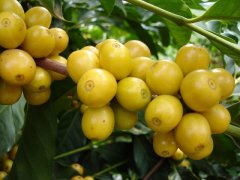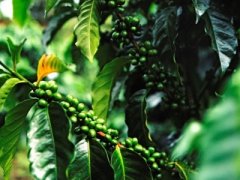Congo Kawa Kabuya Kawakabua Cooperative detailed introduction to in-depth understanding of Congolese Coffee
For professional baristas, please follow the coffee workshop (Wechat official account cafe_style)

Last January, Kawa Kabuya won the TOF competition. The match was held at the UCDA office in Kampala in conjunction with the match in Uganda. Sofie joined the jury to help find the best coffee in the country among the national juries. The coffee she tasted there aroused interest in visiting the two countries and learning more about the areas where they were grown.
In the competition, the coffee from the Cavacabua Cooperative stands out because of its crisp fruit and complex taste. In the months after the competition, we contacted people who helped the cooperative start a business. The quality is there, and the settings sound interesting, so we have to see how we work!
From Rwanda to the Democratic Republic of Congo
After visiting the exporters and processing plants we worked in Rwanda, I crossed the Giseni border on the Rwandan side to Goma on the Congolese side. The next day, after an unforgettable flight in a 16-seat seat, even experienced passengers felt pressure, and I arrived in the heart of Butenbo North Kivu. The plane managed to land safely. Two weeks ago, two planes of a plane failed after an emergency landing. The landing gear of the plane does not work properly, so the plane cannot land on a small unpaved landing gear. The plane must fly back to Goma and dump the remaining fuel to reduce the risk of fire and land on the belly. No one was lucky enough to get hurt. When you are ready to take this plane, you hear the most reassuring story, right next to the plain, when someone is ready to take off and land with fire extinguishers ready! The co-pilot said he would try his best to get us to our destination safely. I don't know if this is a joke.

Either way, we arrived safely after a beautiful 35-minute flight, with unique attractions and an active Nyamuragira volcano close to our left. In Butenbo, I was waited for two people by Elifas, head of the VECO and Kawa Kabuya cooperatives. We continued to go to the VECO office and the headquarters of Kawaya Kawaya.
The management team of the Kawa Kabuya cooperative in Butenbo
Kawa Kabuya's micro-processing plant
After visiting the dry mill in Butenbo, we went to the first microprocessing plant (MSL) in Maniyi MSL, which is located at 1670 meters. The radio group has 603 producers. They make 3MT's parchment coffee together. The average family has 1000 to 1500 trees. As more and more neighbors believe in the benefits of the project, the number of members is growing steadily. In 2014, many producers replanted their farms based on what they learned in training courses. By 2018, they expect to produce a much larger quantity. After visiting Mani, we went to Katanda MSL, which is closer to Butenbo. Many members are young and visionary. They are not satisfied with their inferior materials, as one of them said: quality is the quality of production.
The farmers' members of the cooperative that VECO helped set up are scattered around the mini-laundry stations of at least 50 manufacturers. To join, each member must contribute $50 to help set up the station's infrastructure and purchase all necessary materials for pulpers, drying beds, fermentors, warehouses and offices. VECO and private investors help provide other funds and materials needed. The project began in 2010, when the first cooperatives and farmers' organizations were trained in the production of quality coffee and cooperative management. The first cleaning station was built in 2013.
Coffee in the Congo

Since 1940, colonial Belgians have introduced coffee in the Congo. Coffee production is carried out for families. Everyone must plant many trees. After that, the Belgians built large plantations where the Congolese people worked. Under this colonial system, Congolese coffee production has been a great success. At the end of the Belgian colony, the plantation was abandoned. The Congolese people have chosen different crops to grow on their land because coffee is associated with oppression. Today, most of the plantations in the country are in bad condition. Despite the great potential for coffee cultivation in the eastern part of North Kivu, coffee production is still not very popular.
Eastern Congo is a plateau, fertile volcanic area. The main source of income is agriculture. When a family produces more food than it needs, the product is sold in the local market. The hard work in the fields is mainly done by women. Traditionally, outside the new partnership system, harvested cherries are padded at home or dried directly on the ground. The family sends the dried cherries to the shopping mall in the nearest village or sells them to the middleman. These offer opportunity prices, resell higher prices, and cash in on their own benefits. After the colonial period, some co-operatives were also created, but many of them were fake co-operatives who bought coffee from their members, made false checks and made a lot of money to sell this kind of coffee.
Create quality
Premium Congolese coffee is just a pioneer like the small community project started by VECO. No research has been conducted and government support is low. VECO has worked with UCG to identify some existing varieties and determine the best seedling plan. The Congo has collected and registered the Congolese Arabica plants, including the following species: Rumangubu,Catuai,Kaira,Blue Mountain,Maragogype,Ruiru 11 and Rusiru.
Knowing all this helps to understand revolutionary projects like Kabuyakawaye. Learn more about these things and easily convince you to support the producer community around the miniature cleaning station and grow into a self-sufficient, commercial farm. Being able to communicate with people in these communities and managers of cooperatives can reveal many of the challenges they face in their daily lives, and quality is often their biggest concern.
Actual impact
Since the beginning of Kawa Kabuya, producers have seen their initial investment repaid in the first year. Two years later, they saw their returns double. Because of their focus on quality and appropriate agricultural, processing and selection practices, the prices they have received have so far been invisible in collective memory. They can send all their children to primary school, or even to middle school and university. They can save money, buy more land, build or improve their houses, or get health care. Some of the village elders remember the success of the colonial coffee plantation. The difference now is that the producers themselves have complete control over what happens to the coffee and get all the premiums for the coffee they sell, and how they decide as a community. Kawa Kabuya managed to get 64 per cent of the price of coffee traced back to producers. The other 37% is used to pay taxes, grinding costs and long-term staff, etc. The rest is the money invested in the micro-washing station for the maintenance and improvement of infrastructure.
Cooperative structure
In a cooperative system, the board of directors is elected from among the members of the community. There is a general meeting of the director, treasurer, secretary, control group and all production members. Initially, producers receive 250 francs per kilogram of cherries and harvest advance financing when harvesting cherries. When cooperatives try to sell coffee at high prices, the producer mix determines what happens to the premium. They can choose a second payment to get a more direct income from their work, or they can put money into cooperative funds, reinvest in laundry station infrastructure and improve farms.
The way forward
One of the many challenges facing these new cooperatives is the era of existing factories in Congo. Most of them are 50 to 60 years old. To solve this problem, each washing station is equipped with a nursery. The project has about 2 million plants that can be used for farm renewal. 70% of them have been planted. The nursery also has many compatible shade saplings. It is not easy to persuade producers to plant and reduce production in the next three to four years. Through the training of cooperatives to farmers' schools, attitudes towards coffee production are slowly changing. Producers understand the processes and efforts required for production quality and see the high bonuses returned by their hard work. They see the advantages of being grouped rather than working separately, selling in local markets or engaging in illegal coffee trade with buyers from neighbouring Uganda. This kind of transaction has cost a lot of lives. Few people are shot in dangerous transportation on foot or by bike.
The motivation and the level of investment of the community at the Kabugu base are rare. They believe that coffee and quality are the way out of poverty. I was deeply impressed by the people of the Congo and the diversity of nature. All the potential is there, in a healthy structure. Now we just need to help them regain the reputation of Congolese coffee at other times. Thank you very much to the people of VECO who organized this trip to accompany me on these charming days.
Important Notice :
前街咖啡 FrontStreet Coffee has moved to new addredd:
FrontStreet Coffee Address: 315,Donghua East Road,GuangZhou
Tel:020 38364473
- Prev

Fazenda Santa Rosa Santa Rosa Manor in Brazil introduces the development story in detail.
For the exchange of professional baristas, please follow the coffee workshop (Wechat official account cafe_style) Santa Rosa Manor-Fazenda Santa Rosa, Brazil is located in the mountains near Soledade de Minas in the Mantiqueira de Minas region. The region is the most popular specialty coffee area in Brazil, with many microclimates. Plus the plateau and rich soil, Mantiqueira Demina
- Next

Buwai (Bwayi) processing plant introduces Burundian AA coffee flavor description baking suggestion
For the exchange of professional baristas, please pay attention to the coffee workshop (Wechat official account cafe_style) Burundi AA- Buwai (Bwayi) processing plant Burundi is located in the heart of Africa. It has been growing and producing coffee since 1930. Most of the varieties are bourbon species like those in neighboring Luanda. Coffee grows on mountains 1250-2000 meters above sea level, and about 800000 families in Burundi are growing it.
Related
- Does Rose Summer choose Blue, Green or Red? Detailed explanation of Rose Summer Coffee plots and Classification in Panamanian Jade Manor
- What is the difference between the origin, producing area, processing plant, cooperative and manor of coffee beans?
- How fine does the espresso powder fit? how to grind the espresso?
- Sca coffee roasting degree color card coffee roasting degree 8 roasting color values what do you mean?
- The practice of lattes: how to make lattes at home
- Introduction to Indonesian Fine Coffee beans-- Java Coffee producing area of Indonesian Arabica Coffee
- How much will the flavor of light and medium roasted rose summer be expressed? What baking level is rose summer suitable for?
- Introduction to the characteristics of washing, sun-drying or wet-planing coffee commonly used in Mantenin, Indonesia
- Price characteristics of Arabica Coffee Bean Starbucks introduction to Manning Coffee Bean Taste producing area Variety Manor
- What is the authentic Yega flavor? What are the flavor characteristics of the really excellent Yejasuffi coffee beans?

